Medical Astrology Guide. Death and Disease in Vedic Astrology
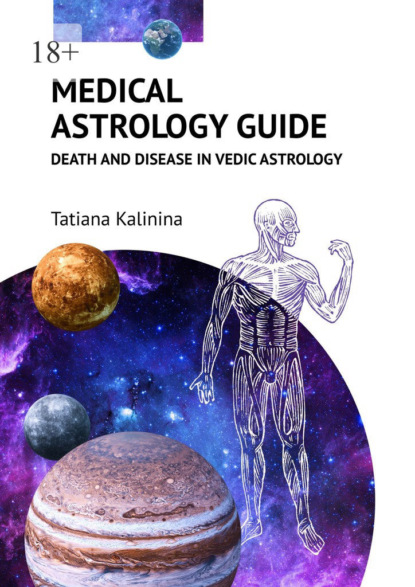
- -
- 100%
- +

© Tatiana Kalinina, 2025
ISBN 978-5-0067-5971-8
Created with Ridero smart publishing system
Preface
The book you have opened contains the results of a study I conducted during the first half of 2020 on identifying the type of death, its timing, and determining the diseases that threaten a person or remain with them for many years.
During my study, I analyzed the natal charts of deceased individuals (80% of the total sample) and those who are still alive (20% of the total sample). I am deeply grateful to everyone who shared the birth charts of their loved ones and themselves with me. Without their trust and generosity, this book, along with the invaluable data I have collected, would not be possible.
As I write this introduction in 2020, the world is grappling with the COVID-19 pandemic, a highly contagious virus causing severe viral pneumonia.
Doctors on the front lines in Spain and Italy estimate a 20—25% mortality rate from the virus, while Chinese authorities report it at 4.5%. European authorities have cited a mortality rate of around 1%. Only time will tell who is right.
While people are hunkering down at home in fear, global economies are experiencing unprecedented turmoil, with billions of people stuck in quarantine. In this chaotic environment, understanding how our Vimshottari periods will play out is more critical than ever: will they bring comfort at home or pose dangers within hospital walls?
I have recently noticed a recurring pattern in the birth charts of those seeking my guidance: the activity of the planets Ketu and Mercury, or the rulers of the 6th and 12th houses. Those more susceptible to lung issues can gain valuable insights into their natal charts and the potential danger periods. I hope this knowledge helps them minimize contacts and stay extra cautious.
I am thrilled that this study will empower astrologers to detect chronic illnesses, identify their onset, and clarify periods that might bring about death.
In this book, I will challenge many classical formulas widely accepted as favorable, while experienced predictive astrologers understand the extent of misunderstanding among others who do not even attempt to forecast using astrology.
I believe astrology was designed for prediction, not for delving into psychological issues or energy diagnostics.
Eastern culture has always prioritized practicality, focusing on survival and social integration. Jyotish emerged out of a need for future predictions, not to analyze personality traits. That is why we have so many predictive techniques at our disposal.
Western astrologers, when transitioning to Vedic astrology, often do not give up their habit of interpreting natal charts for psychological purposes. I contend that prediction is the true treasure of Jyotish, while psychology remains a separate field dedicated to understanding thoughts and emotions. Many disagree with me due to their lack of experience in predictive work with client feedback. As a result, they spread ineffective techniques and ideas that have nothing to do with true practice.
In this book, I will use Navamsa sparingly, doing so intentionally to highlight the importance of the division chart D-6, often overlooked in traditional analyses. Navamsa is a powerful predictive tool, where planetary positions, Yogas, nakshatras, and other key points are interpreted alongside the Rasi chart. For similar reasons, I will not focus on Chara Dasha analysis; instead, I will concentrate on Vimshottari Dasha. A deeper knowledge of this Dasha system will help you be confident in 90% of your judgments, with only a few birth charts requiring verification by other methods.
I urge you to approach the topics of death and disease with philosophical detachment and avoid being overly dramatic. Death and illness are natural parts of life, just like achieving success or starting a family. I have never understood astrologers who make up nonsense about how death and disease are off-limits for study. They say all sorts of things, such as that the astrologer takes on the same fate they predict, or that someone will be born blind in their next life…
I am convinced that only a few can predict with such precision that they can distinguish between sickness and imprisonment or death and job changes. Others justify their lack of skill and unwillingness to learn by spreading these myths.
Remember that something Great controls who comes to you for consultation, at what stage of their life, what they should know, and what they should not. If the Higher Powers do not allow a person to discover dangerous knowledge, the birth chart will reflect nothing but confusion instead of meaningful insights. This concludes the prognosis within the framework of this astrological chart.
Health in Natal Chart
Looking at the birth chart through the lens of health involves identifying its weak points. This approach differs from the usual methods of chart interpretation. It is important to be able to store many small pieces of information in short-term memory in order to make good judgments.
Keep in mind that no planet is simply good or bad. It affects many areas of life, depending on how it is placed in each divisional chart.
So, what are these weak points? In astrology, we operate under the assumption of innocence until proven guilty.
A planet that is not known to be associated with malefic influences or harmful houses is considered neutral by default. If it is not negatively influenced, something we will explore throughout this book, it is regarded as innocent and is likely to support normal health during its period and sub-period of Vimshottari Dasha.
It is also crucial to differentiate between living and non-living indicators of the houses.
For example, the living indicators of the first house reflect health, personal freedom, and overall well-being.
The non-living indicators include social status, talents, personality strength, and similar traits.
The Sun as a malefic, being in the 1st house, will affect the living indicators of the house and enhance the non-living ones. This is the way all malefic planets function, such as Saturn, Mars, Rahu, Ketu, and the previously mentioned Sun.
The negative effects can be minimal if the planet in the 1st house has no significant afflictions from aspects and is not in debilitation. It is advantageous if the planet does not have extreme placements, neither exalted nor severely afflicted by malefics.
For instance, if an exalted Jupiter is located in the 1st house, which happens for the Cancer Ascendant, its period may pose a threat of significant illnesses because it becomes the strong ruler of the 6th house, making it a functional malefic for the Cancer Ascendant.
The fact that people with poor astrological charts live into middle age and beyond indicates only one thing: that very Vimshottari Dasha period has not yet begun.
Overview of Health Condition
It is very important to be able to correctly interpret the birth chart from the perspective of Medical astrology and not to confuse the effects related to career achievements with those concerning health. The same period can bring a dizzying rise in career as well as physical suffering simultaneously.
To assess a person’s health condition and their potential to live free of diseases, it is necessary to examine the natal chart from a special point of view.
Here are the key points on which good health in the astrological chart is based:
– 1st house free from malefic influences.
– A well-placed ruler of the 1st house (not conjunct malefics, not combust, not hemmed in between two malefics, etc.).
– The direct motion of the 1st house ruler and the planets aspecting the 1st house and the Lagnesha.
– The Kendras are occupied by functionally benefic planets without major afflictions.
– Dusthana lords of moderate strength, free from afflictions and not showing signs of exceptional power.
– Malefics placed in the 3rd, 10th, and 11th houses.
– Dusthanas free from planetary occupation.
– Absence of debilitated planets that are connected to the 1st, 6th, 8th, or 12th houses.
It is unlikely that one will find the natal chart that fully meets all these criteria. I will prove this to you by using a reverse approach.
Remember that all people are mortal. This is an unchangeable law of existence in the material world. One of the nine planets must take on the responsibility of guiding a person from death to a new life. Therefore, there will always be a planet or conjunction in the astrological chart that appears threatening.
By keeping in mind that such a planet must exist, you can quickly discern which one it is upon first glance at the natal chart. You just need to look at the Vimshottari Dasha periods to determine the duration of a person’s life and identify when a dangerous period may begin. The rest is purely technical.
I have described an ideal situation where a person never gets sick and dies rapidly due to the influence of a single affected planet. However, it is essential to recognize that a complex of negative influences often arises from other planets and critical points in the birth chart.
The affliction of planets and health arises from the influence of the rulers of the Dusthanas, natural malefics, Gnati Karaka, Maandi, Gulika, and so on.
Even if the natal chart contains no combust or retrograde planets, no planets in fall, and the ruler of the 1st house is excellently placed, there are still factors that are impossible to avoid at birth:
– the Sun, Mars, Saturn, Rahu, and Ketu are always present in the sky;
– there will inevitably be planets that take on the rulership of the 6th, 8th, and 12th houses.
Of the nine planets, only four are considered benefic, while five are malefic. Among these four benefics, two or three may serve as rulers of the 6th, 8th, and 12th houses, rendering them malefic in the context of Medical astrology.
In other words, despite having an overall favorable chart, only one or two planets remain ideal for health, while the rest are afflicted to some degree.
No single planet may be entirely auspicious in many cases. This is evident when examining numerous real-life cases in this book. So, why do these individuals often live into adulthood?
Remember, there is usually one planet or combination that poses a greater threat than all the others. The Dasha of that planet becomes critical, and it often does not begin immediately.
Planets Assessment
When predicting an individual’s health, it is vital to consider not only the natural characteristics of each planet in their natal chart, but also the specific functions the planet performs in that chart and which houses it rules.
I have seen numerous birth charts where disastrous events occurred during the Antardasha of Jupiter or Venus, even though they are considered the greatest benefics in astrology. This underscores the importance of examining the specific functions of each planet within an individual’s chart.
A planet can become malefic for someone’s health if it is:
– positioned in the Dusthana houses (the 6th, 8th, and 12th);
– a malefic planet (like Saturn, Mars, Rahu, Ketu, or the Sun) occupying or aspecting the 1st house or its ruler;
– retrograde;
– in its fall sign;
– the ruler of the Dusthana houses (the 6th, 8th, or 12th houses);
– combusted;
– involved in a planetary war with a Dusthana lord or a malefic planet;
– in conjunction with or aspected by the ruler of the Dusthanas;
– occupies the same house as one or more malefics.
These are the key signs that indicate a planet could negatively impact health during its Mahadasha or Antardasha in the Vimshottari system.
Let us consider an example.
Case Study 1: Underweight and Low Immunity
This woman suffers from low body weight and weak immunity. She also experiences eating disorders and chronic neurasthenia.
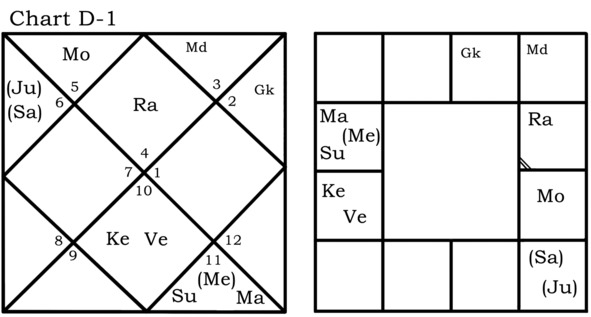

Among all the planets in this natal chart, the most harmful to health will be:
– Saturn, the ruler of the 8th house, is retrograde and conjoined with Jupiter, the ruler of the 6th house. It is also aspected by Mars from the 8th house of crises.
– Jupiter, the retrograde ruler of the 6th house, is conjoined with Saturn and also receives an aspect from Mars positioned in the 8th house.
– Mercury, as the ruler of the 12th house placed in the 8th house, is also retrograde and conjoined with two malefics, Mars and the Sun.
When several malefics converge in one area, the planets with a gentle nature, that are considered benefits, are affected the most. It is similar to a thief feeling far more comfortable among gangsters than an honest person would. That is the situation Mercury finds itself in here.
When a malefic planet is isolated from the 1st house and its ruler, its negative effect may be less severe than if it aspects the 1st house and its ruler, or is placed in the Lagna.
In this chart, Mercury connects to the 1st house through its aspect on the Moon, suggesting that treatments for her current illnesses offer no relief. During Mercury’s Antardasha, the woman faced an aggravation of her eating disorders following her divorce.
This case lacks well-placed planets that would predispose an individual to good health. For strong health to prevail, it is important that some planets in the chart remain unaffected by malefic influences. One can rely on the Dasha of such well-placed planets, especially if they are found in the Kendras.
Looking ahead, we can expect that the Dashas of Jupiter and Saturn will pose particular challenges for her. Both Dashas occur after the age of 40 and are tied to the 8th house, which is associated with death, and both are afflicted by Mars. We should also examine the Chara Dasha to make an assumption about her life span.
The key to accurate prediction is to take a broad view of the natal chart and identify both supportive and harmful combinations within it. This is an extremely useful ability. By doing this, you will be able to notice subtle details and avoid being misled by them.
Jupiter: The Absolute Benefic?
Throughout this book, you will find many cases illustrating that Jupiter is not always a planet of benefits. For an astrologer aiming for high predictive accuracy, it is crucial to examine what the planet has become in this specific astrological chart: a malefic or a benefic.
Jupiter is often implicated in illnesses such as cancer, liver disease, thyroid disorders, and diabetes. Its period cannot be beneficial for everyone. In fact, in many cases, Jupiter is profoundly flawed.
For Jupiter to provide favorable health benefits, the following conditions must be met:
– it should not be Gnati Karaka;
– it should not rule the 6th, 8th, or 12th houses;
– it should not be retrograde, combust, or linked with a debilitated planet;
– it should not be aspected by malefics or by the lords of the Dusthanas.
These guidelines apply to both the main Rasi chart and the D-6 chart.
An affliction of Jupiter in the D-9 chart may relate to matters of marriage, or they may concern health, but its role in the D-6 will be decisive.
To illustrate this, I will present two astrological charts that demonstrate how the roles of natural malefics and benefics can be completely reversed.
Case Study 2: Diabetes
This is the natal chart of a woman affected by diabetes.
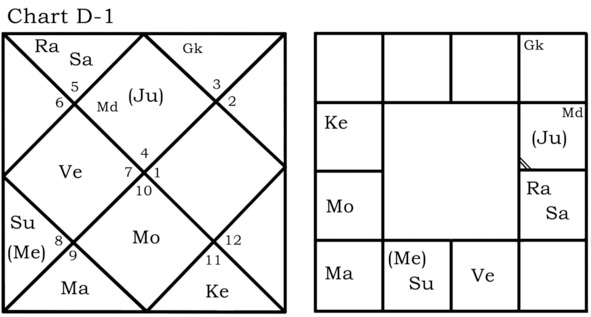

We see an exalted Jupiter located in the 1st house. It seems like nothing could be better.
However, this Jupiter is the lord of the 6th house of disease, which means it acts as a strong malefic in the Lagna.
Despite its exaltation, Jupiter’s functional malefic nature triggered diabetes at the beginning of its Dasha.
Now, here is the second example of a chart illustrating how the roles of benefics and malefics can be reversed.
Case Study 3: Breast Cancer
This chart belongs to a woman who has survived breast cancer twice.
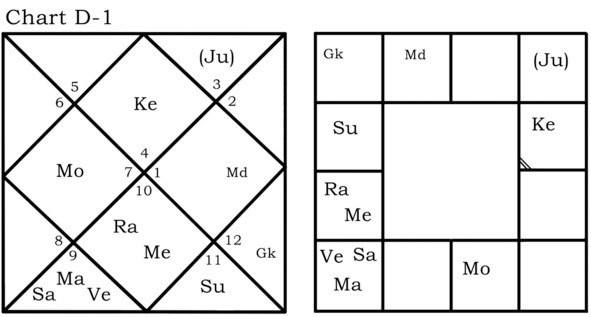

This type of cancer is often observed when the Moon is placed in Libra, particularly in conjunction with the fixed stars Unukalhai and Zubenelgenubi (also known as the Southern Claw), both of which are traditionally associated with oncological tendencies.
In this chart, there are indications that the illness may lead to complications – the ruler of the 8th house is placed in the 6th, and Jupiter, the ruler of the 6th house, aspects the ruler of the 1st house.
During the Saturn—Moon period, she fell ill for the first time.
Saturn forms classic combinations associated with severe and chronic illnesses: it rules the 8th house, is placed in the 6th house, and receives the aspect of retrograde Jupiter, the lord of the 6th house.
The Moon is placed in Vishakha Nakshatra, which is ruled by Jupiter. Jupiter is an indicator of illness for Ascendant Cancer natives. The Moon, ruling the 1st house of health, is afflicted by the aspect of retrograde Jupiter from the 12th house of healing and hospitals.
During the Saturn-Mars period, the woman experienced a remission of the disease, suggesting that it had receded.
In this context, Mars played the role of Raja Yoga Karaka, effectively overcoming the afflictions associated with the 6th house. If I had relied solely on Mars’ natural significations back then, I would not have been able to make an accurate prediction about the recovery.
However, during the Saturn—Rahu period, the illness returned.
Rahu, being a malefic, was conjoined with Mercury, the ruler of the 12th house. Afterwards, the woman went into remission again.
When the Saturn—Jupiter period begins, the illness is likely to return once again.
These cases highlight that although Jupiter is often regarded as the greatest benefic, especially by those who study extensively but lack hands-on experience in predictive astrology, its role can be complex and sometimes harmful, particularly when considering its afflictions and rulerships within a chart.
Gnati Karaka
A planet that takes on the function of Gnati Karaka (GK) is dangerous to human health. Gnati Karaka is the significator of the 6th house in the Jaimini system. It indicates troubles, debts, conflicts, and ailments.
When examining the Vimshottari Dasha period or sub-period of the planet identified as Gnati Karaka, one must exercise caution, as this can often signal harmful influences for the health of the native. This becomes especially pertinent if Gnati Karaka aspects the 1st house or its ruler, or if it is closely conjoined with them.
It is noteworthy that the strength of Gnati Karaka plays a crucial role in determining its impact. If Gnati Karaka is significantly strong or weak, it has the potential to cause greater harm. It is preferable for the Gnati Karaka in the astro chart to have moderate strength: being placed in a friendly sign and not significantly influenced by conjunctions with other planets.
An exalted Gnati Karaka, conversely, tends to indicate formidable resistance and significant obstacles, particularly in the house it occupies.
For example, if Gnati Karaka occupies the 1st house or is positioned near its lord, the individual may encounter challenges related to health and overall well-being.
Let us take a look at the natal chart of Prince Albert II, Prince of Monaco.
Case Study 4: Prince Albert II
On March 19, 2020, the whole world learned that the Prince had contracted COVID-19.
The Dasha of Saturn began in the birth chart of the monarch on February 29, 2020.
At the time of infection, he was experiencing the Saturn—Saturn period.
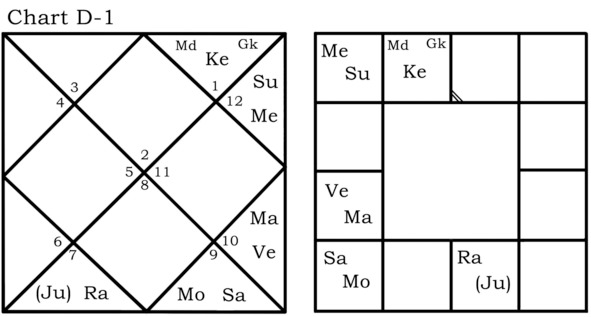

In this example, Saturn serves as Gnati Karaka. It is positioned in the 8th house, in conjunction with the Atma Karaka, the Moon.
The divisional chart D-9 is also not very favorable for Albert.
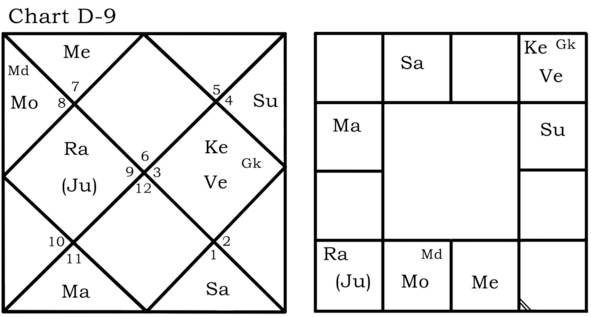
Saturn, which rules the 6th house of disease, is debilitated and located in the 8th house of death and the escalation of any issue, whether it be a conflict, a lawsuit, or an illness.
Without a doubt, the Saturn period is the most difficult one in this chart – the period, the one that stands out.
An illness occurring right at the beginning of the Saturn Dasha is a bad omen, pointing to the characteristics of the ruler of the period.
If you lack sufficient knowledge and experience, be sure to ask the client about what transpired during the Antardasha of that particular planet. This will help you understand the nature and influence of the planet in the natal chart at hand.
In Prince Albert II’s D-6 divisional chart, it is evident that the Saturn Dasha is particularly perilous.
Saturn rules the 12th house of treatments, and its condition indicates that medical interventions during this time cannot fully cure the individual.
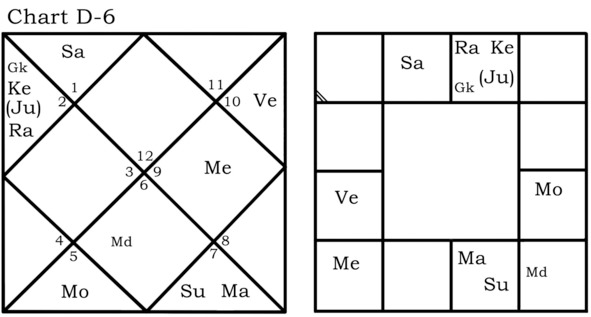
Saturn is aspected by Mars and the debilitated Sun from the 8th house of death. Moreover, the Sun is the ruler of the 6th house of diseases.
Case Study 5: Car Crash
Below, you can see the astrological chart of an individual who tragically died in a car accident.
This happened during the Venus-Saturn period.
In this example, Venus is the Gnati Karaka and is positioned in the 6th house.
Saturn, the ruler of the 6th house, is placed in the 8th house, which contributed to the fatal outcome.
The 8th house of this natal chart clearly indicates a violent death. Three of the most malefic planets are situated here, suggesting a lack of longevity.
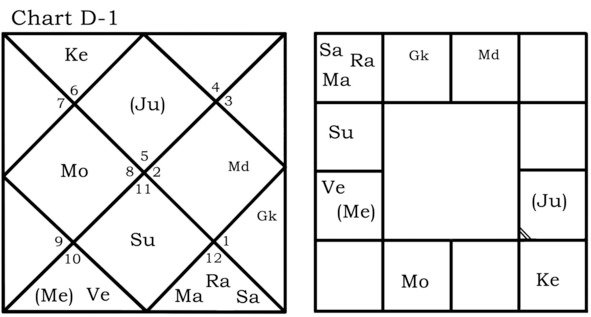

We can revisit this case later to analyze it further in order to determine the nature of the death.
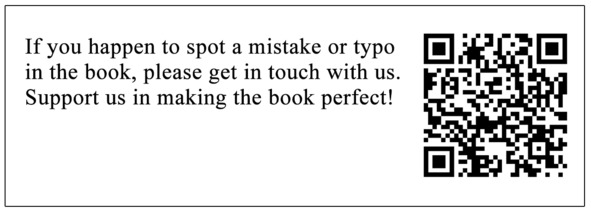
Maandi and Gulika
The shadow points Gulika and Maandi play a crucial role in evaluating planetary influences that may negatively affect the native’s health. These Upagrahas are highly malefic and destroy everything they come into contact with.
It is favorable when they occupy different houses, as this means they never influence the same area of life simultaneously, and therefore cause less harm.
When assessing a person’s destiny using the principles of Chara Dasha, we must continually shift the temporary Lagna to the sign of the zodiac whose period is currently ruling the individual.



